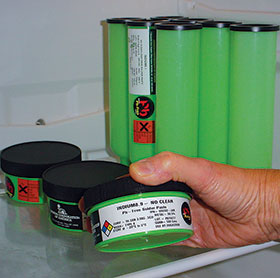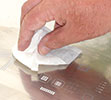

Training and education are fundamental to achieving the highest quality levels and maintaining consistency in a modern manufacturing facility. Although the content is very important, so is the training structure and the correct assessment of staff’s understanding, regardless of level.
The same structure should be applied to engineering and production technicians. Training should be as practical as possible – this may take longer but it’s much better in the long term.
Training and education are fundamental to achieving the highest quality levels and maintaining consistency in a modern manufacturing facility. Although the content is very important, so is the training structure and the correct assessment of staff’s understanding, regardless of level.
The same structure should be applied to engineering and production technicians. Training should be as practical as possible – this may take longer but it’s much better in the long term.
I have been associated with four-day training sessions on paste printing where solder paste is never printed. Does that make any sense? Not my ideal method of training. Today there is a wide selection of training delivery methods, and it’s good to use a selection of techniques while still maintaining the specific content required. Training methods could include hands-on sessions, video or interactive PC sessions, online training and assessment, theory lectures, and books and instruction manuals.
Any training document used is intended as a guide to the training of company staff in the handling and assembly of printed boards containing conventional and surface mount components. The training procedure should be applied to all staff that will be expected to work in the manufacturing areas. It is also beneficial for engineers, supervisors, purchasing and stores staff to receive selected training modules so they have a better understanding of the company business and how their position can impact on the products being produced.
In the case of previous experience from another company, staff should provide evidence of prior training relevant to the skills required for electronics assembly, or undertake a re-evaluation of their skills. There should be some assessment of eyesight and of course colour blindness. If suitable, national or international certification in appropriate areas may be considered. As a further alternative they may take selected interactive tests used on existing training courses at their company interview or induction.
Having a structure is all well and good but many companies just don’t have the resources for this level of support and may have to resort to a simpler approach. In this case the content of the training and staff’s understanding is of prime importance. Online training with webinars on selected subjects is by far the most cost effective option in the industry as there are no travel or accommodation costs, since the training session is conducted on site at a set time. There are many commercial offerings throughout the world but again, it’s better to add structure.
It’s simple to make a list of process or assembly skills required by your team and set a specific time and day per month for training. For example you could have a training session on a Thursday afternoon before the end of a shift for 60 to 90 minutes. Always allow some time after the session for discussion and questions and to make people aware of the next month’s training. In this way, over the course of a year, a group of staff will learn twelve new skills. Obviously the training can be more frequent if desired. The best way of delivering this is with online webinars specific to your company.

Training providers
All training should be presented by authorised company trainers who have had relevant theoretical and practical experience in the areas required. They should also be familiar with training methods and, most importantly, should love training – if you don’t get a buzz from training people, don’t do it.
Authorised trainers must also have been trained in the methods and practices to conduct structured training courses. A listing of authorised training staff for each discipline should be held and maintained by the personnel and quality departments. A register of external training providers should also be held.
Facilities and resources
The materials and equipment required for the training modules should be listed for each session and should be provided for each trainee. A conference room, computer, projector, video player and screen may be required for some sessions, and a notebook, pen and assessment form are required for each trainee before starting the session. It is the personnel department’s and trainer’s responsibilities to confirm that the necessary materials and equipment are ready before starting a training session. Always check before a session that everything is in place.
A copy of the training session notes should be provided for each trainee for them to retain in their training notebooks, and I’m of the opinion that this should be provided after the course rather than before. A course evaluation form should be provided to each trainee for completion to assess the value and success of the training session in the eyes of the trainee. A copy of completed forms should be sent to the personnel department and held on file or added to online records.
When necessary the trainer will need to confirm that any additional production equipment or resources necessary for the course will be made available for the duration of the training. Confirmation should be obtained from the relevant production manager or supervisor prior to starting a course. Each trainee should be informed in writing or email of the training session and what the session will cover. Wherever possible the trainee should be informed a minimum of a week prior to the course date. Many times, staff are told the day before or even worse, on the day of the course – not good planning.
It is good practice to make sure that key elements specific to the company should be conveyed to all staff members. These are often referred to as key or core elements, and include:
• Statutory health and safety
• Fire precautions and procedures
• Accident and first-aid procedures
• Protective clothing and safety equipment
• Maintaining a safe working environment
• Interpreting work instructions and engineering drawings
• Obtaining samples and checking for quality
• Self checking of production samples
• Maintaining quality in production
• Using common production hand tools
As an example, the following could be part of a typical assessment after a training module on solder paste and its use.
Assessment of trainee
The following questions should be answered by each trainee after the completion of the training modules. A copy of the questions should be
provided to the trainee for completion. A score of 12 or more is required to pass the module.
How is the correct stencil selected for a job?
(2 marks for correct answer)
Name four key points on printer setup.
What are the elements of a solder paste?
Where is the snap-off height measured?
How often should the print quality be checked?
Where should the paste thickness be checked?
What size of squeegee blade is used for a 10” board?
What cleaning fluid is used for stencils?
Where are the protective gloves stored for printing?
Trainee performance record
Training Module:
Assessment Results:
Trainee’s Name:
Trainer’s Name:
Possible Marks:
Marks Scored:
Percentage:
Pass/Fail/Retry Test/Continue Training:
Other Comments:
Trainer’s Signature:
Quality Manager’s Signature:
A copy of the performance record should be provided to the personnel department, with a copy retained by the trainer. This can be a paper-based system or maintained with many of the computer-based software systems available in industry.
Good training + Practical assessment +
Structure = Continued success
Bob Willis has been providing staff training for over 30 years, in the form of theory, hands-on, video and computer-based courses commercially offered by SMTA, SMART Group, IPC and many others. He has also created training materials for other commercial companies. For the last few years he has been running online training webinars on over 30 design, assembly and soldering process topics.
For more information visit www.bobwillis.co.uk
© Technews Publishing (Pty) Ltd | All Rights Reserved